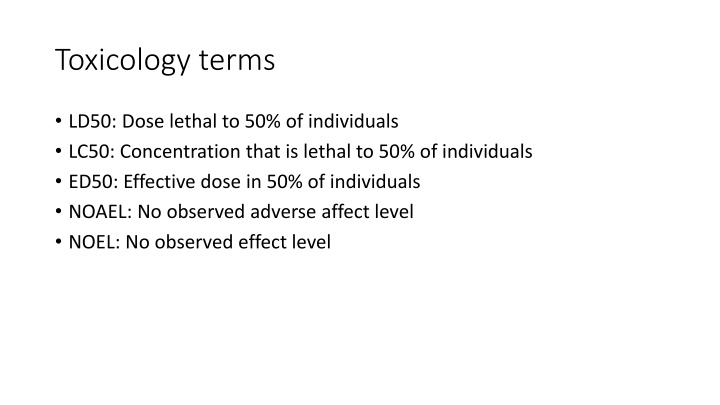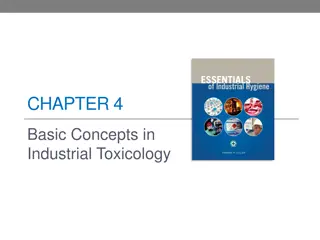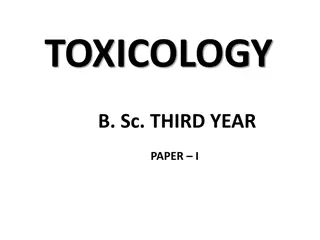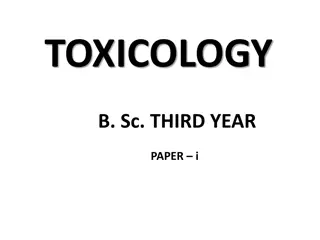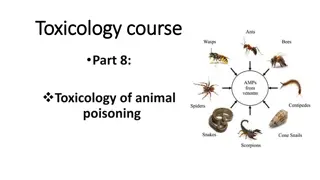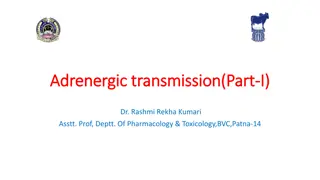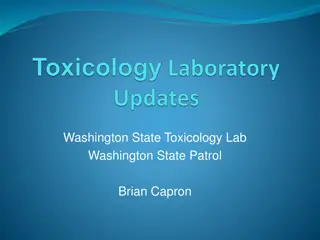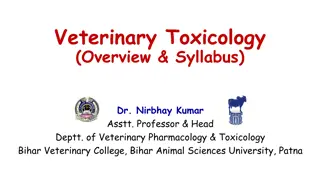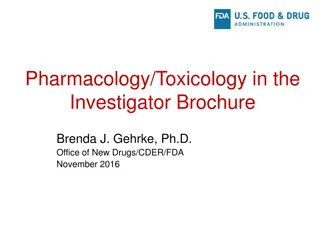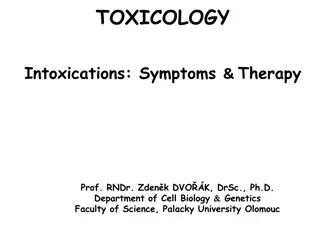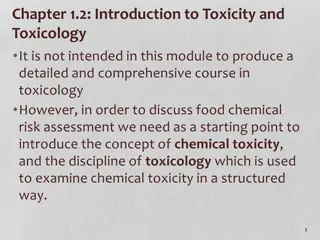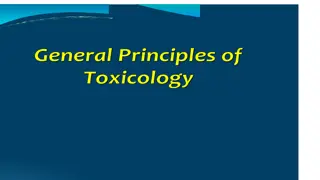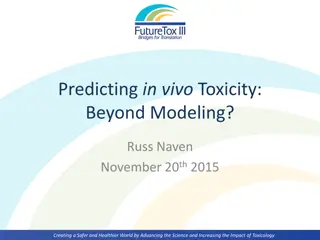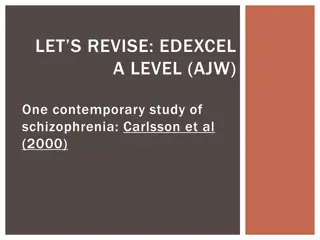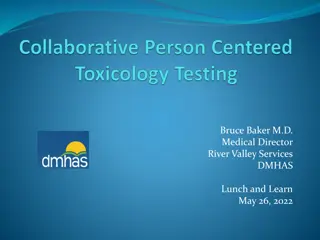Introduction to Toxicology and Neurotransmitters
This content provides a brief overview of toxicology terms like LD50, LC50, ED50, NOAEL, and NOEL, along with simplified explanations of signaling mechanisms and ion channels. It also introduces key CNS neurotransmitters such as dopamine, serotonin, norepinephrine, and glutamate, shedding light on their functions. Moreover, it touches on the significance of dopamine and serotonin transport proteins and their roles in drug abuse and mental health. The information shared here serves as a foundational understanding of toxicological concepts and neurotransmitter functions in the central nervous system.
Download Presentation

Please find below an Image/Link to download the presentation.
The content on the website is provided AS IS for your information and personal use only. It may not be sold, licensed, or shared on other websites without obtaining consent from the author.If you encounter any issues during the download, it is possible that the publisher has removed the file from their server.
You are allowed to download the files provided on this website for personal or commercial use, subject to the condition that they are used lawfully. All files are the property of their respective owners.
The content on the website is provided AS IS for your information and personal use only. It may not be sold, licensed, or shared on other websites without obtaining consent from the author.
E N D
Presentation Transcript
Toxicology terms LD50: Dose lethal to 50% of individuals LC50: Concentration that is lethal to 50% of individuals ED50: Effective dose in 50% of individuals NOAEL: No observed adverse affect level NOEL: No observed effect level
Signaling mechanisms (very simplified!) Slowest (hours to months): Hormones, receptor density changes, gene expression Medium (minutes to hours): neurotransmitters, hormones Fastest (seconds or less): Electrochemical, neurotransmitter
Ion channels The body uses multiple different ions to transmit signals Sodium/Potassium: Primary ions used to maintain resting transmembrane potential and initiate action potentials Ca: Triggers neurotransmitter release in many synapses Involved in gene expression among other things Mg: Tends to inhibit release of excitatory neurotransmitters, also acts as antagonist at the NMDA receptors Types of channels: Ligand gated: A neurotransmitter binds to open/close Voltage gates: A voltage change opens/closes Leakage: Always open
Some CNS Neurotransmitters (very simplified!) Dopamine: Motivation (note, NOT pleasure!) Serotonin: Attachment Norepinephrine: Energy/Alertness Glutamate: Low level CNS excitatory neurotransmitter NMDA: Special subset that is a target of some anesthetics (eg ketamine, pcp), also responsible for much of the negative effects of alcohol withdrawals
Dopamine Dopamine transport protein is a target of many drugs prone to abuse Amphetamines (also used as an ADHD drug) Cocaine (also used as an anesthetic, due to unrelated action) Long term high levels are associated with schizophrenia Causes excitotoxicity in high concentrations
Serotonin Ancient in origin Behavioral effects in octopi are very similar to humans In brain controls attachment, well being, hallucination (mostly 5HT2a), bonding Outside CNS controls body temperature, digestion, circadian rhythm Pharmaceuticals that target Serotonin transport proteins are used as anti-depressants (SSRIs)
Acetylcholine (simplified) Excitatory neurotransmitter Expressed in sympathetic nervous system In PNS controls motor neuron activation In CNS affects motivation, alertness, concentration In insects, expressed only in CNS Some pesticides act as agonists here, or bind to acetylcholinesterase
Acetylcholine (less simplified) 2 main categories of receptors Muscarinic Named for muscarine, first agonist discovered Mostly responsible for re-polarization Agonists cause delirium, pain relief, slow heart rate, and death at high doses Nicotinic Named for nicotine, a relatively strong agonist Associated with selective and nonselective ligand gated channels Mostly responsible for depolarization Agonists cause muscle spasms, seizures, and death at high doses
GABA Generally inhibitory Agonists and some modulators act as anti-anxiety or anti-convulsive agents Agonists usually cause dependence rapidly; withdrawal can lead to seizures and death Some pesticides are agonists for this, but less common than acetylcholine based pesticides
Hormones: Estrogen: Female sex hormone, but also has a role regulating water retention, muscle growth and blood pressure in men Testosterone: Male sex hormone, but also has a role regulating muscle growth, aggression, and sex drive in women Cortisol: Mediates stress response
Neurotoxins Neurotoxins are chemical agents that directly or indirectly cause damage to tissue in the nervous system (or impair its normal function). There are many ways that a substance can be neurotoxic, the details vary wildly Many beneficial medications are neurotoxic (especially at higher doses) Many neurotransmitters are neurotoxic (especially at elevated concentration)
Chemical neurotoxins Pesticides Acetylcholinesterase inhibitors: Cause damage by allowing excessive acetylcholine to build up in the synaptic cleft which leads to damage from over activation of the associated neurons. Note that the death of neurons is not really responsible for the lethal effects The most toxic examples have LD50 of ~1mg/kg orally Bacteria Botulism toxin is the most toxic substance known (LD-50 ~10ng/kg by inhalation). It works by destroying SNARE proteins associated with the release of acetylcholine. This prevents any release from occurring, leading to paralysis and death by respiratory depression.
Heavy Metals Water soluble mercury compounds Methylmercury: Created from mercury by microbes in the ocean and bio- magnifies. Very long biological half life (~50 days) and toxicity (LD50 ~20mg/kg) Dimethylmercury: Extremely toxic (LD50 <50mcg/kg). Found in the ocean in very small quantities. The origin remains unknown. Molecular mechanism of neurotoxicity remains unknown Lead compounds Mostly from action of acidic water on lead pipes Example: Flint, Michigan Arsenic: Mostly natural sources
Other neurotoxins Dopamine Dopamine has several breakdown products that damage dopamine and serotonin neurons Glutamate In high levels, glutamate causes cells to intake too many Ca2+ ions. This results in over-activation of proteins in the cell that damage it. (called excitotoxicity) Amphetamines Releases dopamine and serotonin (already involves some neurotoxicity) Many have metobolites that are directly neurotoxic to dopaminergic or serotonergic neurons
Mutagens Mutagens change DNA structure Many lead to increases in cancer rates Asbestos: Common insulation material in the 1970s. Fibers are highly carcinogenic. Radon: Naturally occurring radioactive gas that is a decay product of radioactive isotopes (notably radium).
Teratogens Interfere with normal fetal development, causing birth defects. Alcohol: Leading cause of birth defects in USA Pharmaceuticals: Many drugs act as teratogens. Thalidomide: Given to pregnant women as an anti-nausea drug in the 1950s. Led to lots of birth defects.
Endocrine disruptors Drugs that mimic a hormone found in the body Very often mimic estrogen Phthalates: Chemicals used to make some plastic more pliable Mimic estrogen Being phased out Many insecticides and herbicides (DDT, Atrazine, ) Probably as a result of endocrine disruptors, males testosterone levels are rapidly declining https://www.urologytimes.com/view/testosterone-levels-show-steady- decrease-among-young-us-men
Discussion Questions How can we objectively determine and represent the risk of something? How should risk of environmental or human harm be balanced against availability of new products and what should the threshold be for removing an existing product from the market? How should human risk be balanced against environmental risk?
Design an experiment to answer each question. How much does penicillin resistance impact resistance to methicillin? (hard) Which of 2 viruses is more deadly to mice? (easy) Does a vaccine for Covid work in humans? (medium)
